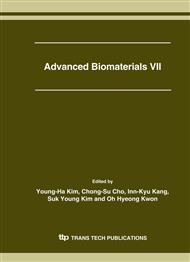p.793
p.797
p.801
p.805
p.809
p.813
p.817
p.821
p.825
Ozone-Induced Immobilization of Chitosan and Heparin on Polyethylene Terephthalate Films to Improve Antithrombogenic Properties
Abstract:
of artificial blood catheters. This paper describes the immobilization of chitosan and heparin molecules on polyethylene terephthalate (PET) films by ozonization. The concentration of peroxide groups (-OOH) was 1.72 × 10-7 mol/cm2 on the PET surface oxidized by ozonization. The results of X-ray photoelectron spectroscopy (XPS) indicate that chains of chitosan and heparin were successfully immobilized on the PET films. The static contact angle(STA) of water decreases from 83.5° to 68.3° by immobilization of chitosan and heparin, which means that the hydrophilic properties of the modified PET is improved. The antithrombogenic property of PET surface was evaluated by a platelet-rich plasma (PRP) adhesion test. The results indicate that the number of platelet adhered on the modified-PET surface incubated with PRP for 240 min decreased significantly and platelets did not aggregate and distort.
Info:
Periodical:
Pages:
809-812
Citation:
Online since:
July 2007
Authors:
Price:
Сopyright:
© 2007 Trans Tech Publications Ltd. All Rights Reserved
Share:
Citation:


